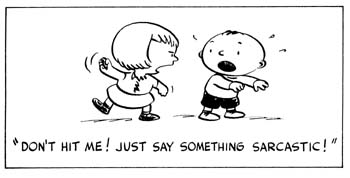![[Metroactive Books]](/books/gifs/books468.gif)
[ Books Index | Metro | Metroactive Central | Archives ]
Winner of Discontent
 Survival Tactics: That round-headed kid Charlie Brown learned early in life that peer pressure is just another form of peer abuse. With competition from 'The Rugrats,' how does 'Peanuts' survive? THE COMIC reproduced with this column is an early panel, circa 1950, by Charles M. Schulz reprinted in Rheta Grimsley Johnson's 1989 biography of the Peanuts cartoonist, Good Grief: The Story of Charles Schulz (Pharos Books). Study the cartoon for a second. How modern it is! It could have been drawn yesterday by Eightball's Dan Clowes, Optic Nerve's Adrian Tomine or Acme Novelty Library's Chris Ware; the anti-joke punch line could have been Bongo's plea to his looming father in Matt Groening's Life in Hell. (Groening has togged out his characters Akbar and Jeff in zigzag shirts as an homage to Charlie Brown.) According to Johnson's biography, Schulz is as modest as a minister, and just as uncomfortable with sex and the sort of language most of us use to describe life's rich tapestry. So I doubt that Schulz would be interested in explicit comics, any more than he'd be interested in The Rugrats or The Simpsons. And the feeling is mutual. The days when Peanuts was hip are 30 years gone. Yet avant-garde comics would not be where they are today without the confessional, downbeat humor of Peanuts. The first installment of Peanuts, published Oct. 2, 1950, has the following script (the visuals can be easily imagined by anyone who has spent some time in the company of Peanuts): "Well, here comes ol' Charlie Brown, good ol' Charlie Brown! Yes sir, good ol' Charlie Brown ... How I hate him!" Try selling something like that to today's newspapers! No proactive hero--Charlie Brown is famous for his wishy-washiness. No interaction with comforting parents to promote family values. Director Atom Egoyan (The Sweet Hereafter) has been described as the founder of the cinema of disappointment; Schulz was the founder of the comics of disappointment. The world is never idealized for the characters; the distractions of pleasure are always brief. The failure-prone Charlie Brown embodies the introversion and unhappiness of childhood. Many a kid first learned the useful word "depressed" from Peanuts. Any cartoonist exploring this kind of artistic terrain today wouldn't have a chance anywhere else but Fantagraphics, Drawn and Quarterly, Black Eye or some of the other small-press comics publishers. Out of vogue, but not out of print, Peanuts continues in its place on the daily paper's comics page. It's sealed off, never hilarious, almost always wistful, lonely and remote. If the comics page could be heard instead of seen, Peanuts would sound like the mournful tones of a Japanese bamboo flute. Surrounding Peanuts are garish, badly drawn strips full of demographic appeal: career-girl gags, dorm-room laffs, ugly cats and ugly dogs dreaming about food. There are the commonplace panel gags, whose labored puns give an excellent example of the difference between humor and whimsy. Gimmicks, all of them. With the exception of Lynn Johnston's For Better or for Worse, is there any strip on the page that couldn't be drawn and written just as well by someone else? WHEN HE BEGAN as a cartoonist, Schulz's rivals on the comics page were action strips, family dramas and the hillbilly satire Li'l Abner. The reduced size of Schulz's comic strip was its prime selling point--United Features Syndicate advertised Peanuts as "The Greatest Little Sensation Since Tom Thumb." Working in a small space, Schulz emphasizes faces instead of bodies; the small drawings make the words more important than the action. Though Schulz's most popular character, Snoopy, is mute, he thinks in cartoon bubbles, just as every animal in comics does to this day. Snoopy's reveries were part of the gag about the star's insignificance; the permanently excluded round-headed kid Charlie Brown was a straight man even to his dog. Those who were children during Peanuts' most popular days in the 1960s loved Snoopy, but most of them knew they were Charlie Brown. Schulz's work persists, something like the pure expression of an artist in the middle of the cautious, corporate daily paper. I doubt anyone will appreciate Schulz's accomplishments completely until that day comes when Peanuts is no more. What a comfort Schulz has been over the years to children who learned early that some people are born to fail. "Losing is what has kept Peanuts living after 40 years," biographer Johnson wrote in 1989. How many people besides Charles Schulz have made a fortune sympathizing with losers? [ San Jose | Metroactive Central | Archives ]
|
From the January 7-13, 1999 issue of Metro.
Copyright © Metro Publishing Inc. Maintained by Boulevards New Media.